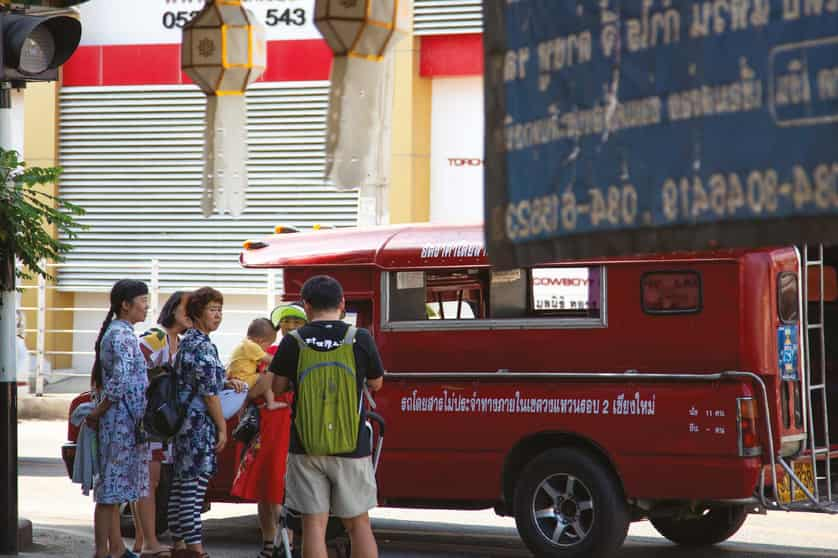It was about four or five years ago when Chiang Mai went into shock with the sudden influx of Chinese tourists who poured into the city following the success of the movie Lost in Thailand, which featured many Chiang Mai landmarks. Suddenly, there were large and often loud groups of Chinese tourists at every temple, park, shop, restaurant — everywhere. After the initial shock came some resentment, as news of a handful of tourists misbehaved or were considered ill mannered. But then the economy began to see a real growth and the murmurings of resentment stopped as pockets were lined, more and more businesses opening up to support this emerging influx of visitors. The past year saw a slowing down of incoming Chinese tourist numbers and now we are hearing people bemoan the lack of Chinese tourists. So we thought we would take a look at where we are with our Chinese visitors and what the future holds for us both.

“10 years ago the number of Chinese tourists in Chiang Mai was less than a hundred thousand a year,” said Pornchai Jitnavasathien, the board committee of Tourism Development in Lanna Civilisation and former president of Chiang Mai Tourism Business Association. It was also around that time, 2008, that we had political conflicts, mobs on the streets and the infamous airport closure in Bangkok. Suddenly Chiang Mai and other regional destinations began to be more attractive to visitors, according to Pornchai. “The travel route changed from Bangkok – Phuket – Chiang Mai to Chiang Mai – Phuket – Bangkok, and maybe even back to Chiang Mai,” said Pornchai.
During that time, Thai soap operas, broadcasted in China, started to gain a following, according to Dr. Korawan Sangkakorn, a researcher at the Centre of Tourism Research and Development (CTRD), Chiang Mai University. “In 2007, I attempted to conduct research on Chinese tourists, but did not succeed as planned as there were too few of them,” stated Dr. Korawan while adding that “at that time the main reason for Chinese people to travel to these regions – Thai, Singapore, Malaysia – was to visit their relatives.”
Then come the Lost in Thailand phenomena, a hit Chinese movie released in 2012 featuring Chiang Mai in many scenes. “It was like free marketing for us. But imagine if the word got out that we were not ready, the market would not have grown the way it has today. We were ready. Facilities like the airport, service providers like tour agencies and guides were already available. The film just triggered what was already growing, accelerating it even more,” said Pornchai. In 2017 Chiang Mai welcomed over 970,000 Chinese visitors, according to the Tourism Authority of Thailand Chiang Mai Office. They were dominating the market, leaving the US tourists far behind in second place with only 200,000 visitors.
“Chinese tourists are a major factor driving the various airlines to expand their routes,” said Pornchai, explaining that from only having three direct flights to China – Kunming, Hong Kong and Macao – Chiang Mai is now connected to China in almost every region. One of the most significant direct flights is the Chiang Mai- Guangzhou route, Guangzhou being one of the busiest airports in the world. “The fact is a flight to China does not mean all of the passengers are Chinese, they could be anyone from any country who are travelling. If I am to go to the US from having to transfer in Bangkok, now I can just fly from here to Guangzhou and then to the US, just like that, saving me many hours’ travelling,” said Pornchai, adding that 27 new terminals in Chiang Mai International Airport have opened over the past decade to support the Chinese tourism growth.

“The Chinese, like many other nationalities, love our friendly faces. Our slow sabai sabai lifestyle is charming to them, as is our cultural heritage and natural resources. At the core of their fondness towards us is the fact that we have a similar mindset, and this has a huge impact. Like us, they too value family. They live closely with a number of relatives, their colleagues are like brothers and sisters. So if they like something, similar to Thais travelling abroad, they will just buy a whole bulk of it to give away to their family and friends. Our cultures are similar. At the temple, western tourists would only go to take pictures and maybe use the restroom, but Chinese tourists have to go into the viharn, they will renting sarongs, many even buy packs of Buddha images to take home. We wear similar clothes and our tastes are not dissimilar, so they like our décor items and souvenirs, which fit in well into their homes,” explained Pornchai, adding the number that the average Chinese spends per person per day is about 5,000 baht. The average international tourist spends around 4,000 baht per person per day according to Tourism Authority of Thailand, Chiang Mai Office. “Most of them are not the wealthy Chinese, but they are willing to empty their pockets and spend what they can when they are here,” said Pornchai who went on to say, “while the Japanese are high quality tourists whose high standards we can barely meet, when it comes to the Chinese who are a mass market, when they spend money, it is like an atom bomb goes off.”
The tourism industry often divides the market into two: the tour groups and the free independent travellers (FIT). The same goes for Chinese tourists. At the begging of the growth of the Chinese market, the majority of those travelling came through packages of tour agencies. “Around 60-70% were in tour groups. With the growth of their economy, they can afford more variety in their travelling. Their accessibility to the internet and higher education opens the doors to information, giving them tools to create their own travel plans. Now the ratio has swapped with less than 40% coming with tour agencies and 60% are FIT,” explained Pornchai.
According to Airports of Thailand, last year’s international arrivals grew by 9.9% while this year the growth rate has slightly dropped to around 8%, but it’s still growing. “Around 80% of the international arrivals are Chinese. So, the impression that tourists have all gone away, with some media reporting 40%-80% drops, is simply wrong,” stated La-iad Bungsrithong, the Vice President of Thai Hotels Association and the general-manager of RatiLanna Riverside Spa and Resort. “Their travelling style has shifted, not a sudden change, but the number of FIT has been growing exponentially in the past four to five years while those with tour agencies continue to drop. The noises of distress buzzing around about the decrease of Chinese tourists is actually from those working in the tour agency business,” explained La-iad pointing to reports by Association of Thai Travel Agents (ATTA). The figure reported by the Ministry of Tourism and Sports falls in line with what La-iad says, with 49 billion baht gained in revenue nationwide from Chinese visiors, up 13% from last year.

“The issue here is that small and medium businesses are not swift to adjust to the market. Most of them don’t have a business strategy, simply hoping that tourists will come knocking on their door,” said La-iad adding that Chiang Mai has at least a whopping 30,000 rooms, including thousands of Airbnb accomodations, creating numerous alternatives to travellers. “We didn’t even know what a hostel was a few years ago, and now they are everywhere. But the truth is I don’t think that Chinese visitors prefer hostels; I’d say they appeal more to European travellers. It is this level of understanding that entrepreneurs need to have. In 12 months, Chiang Mai welcomes difference people from different countries, and a business strategy is needed to navigate each group through the year. But one thing that is happening for sure is group tours will continue to decrease,” said La-iad.
Pornchai explained that the FIT travel here all year round at a flat rate while the tour groups peak during our low season because hotels and flight tickets are cheaper and that lowers the price of the tour package. Our high seasons sees more FIT tourists from China, while the package tour groups tend to come in the low season. That’s why in the past four to five years Chiang Mai did not really have a bad low season. “Next low season may be a problem as tour groups continue to drop.”
“It’s going to be really bad if the government continues to scratch at the wrong place,” said Pornchai referring to the waiving of the arrival visa fee in December and January. “The timing is just ineffective. These are the people who have decided to come already and have money to spend. I doubt very much that this will have much impact on their decisions, and we just lost a passive income. And Thailand says we want to be a high standard destination.”
La-iad gives us a similar opinion in a slightly more diplomatic tone saying that “It’s just a short while,” and adding it is the Association of Thai Travel Agents who are pushing the cabinet to waive the fee. “It’s just a couple of thousand baht. Ask yourself, when you travel, does the visa fee factor into your decision to visit a country?” asked La-iad who said that this decision was pushed forward by those who want to see the return of growth numbers from five years ago.
“The urgent issue needs to be addressed here is our quality as a destination,” said Pornchai. According to Minister of Tourism and Sport told Thairath that about 40% of Chinese tourist deaths worldwide occur in Thailand. A shocking number which was felt acutely last year with the infamous comments made by our Vice Prime Minister, blaming the Chinese for their own deaths, following the capsized boat in Phuket which killed 46 people. “Then there are ongoing problems of food poisoning, police checkpoints on roads, overpricing and scams. “These are urgent matters that have a direct impact on their decision to come here, both for first time visitors and those returning. Word gets out really fast these days,” said Pornchai.
“Unlike Pattaya, we have the advantage of direct flights and the majority of international terminals are connected to China, whereas Pattaya doesn’t have that,” said La-iad, who insists that numbers have not dropped as is the public perception. “I have my Chinese students translate news reports in China and people were saying that they won’t return to Thailand. It was obvious that our credit has dwindled down,” said Dr. Korawan emphasising that our quality as a destination needs to be addressed.
La-iad sees that with a population of 1.4 billion people, there are plenty of Chinese to come. While the growth rate has not skyrocketed, she isn’t upset by this, “we don’t want tourists swarming our city, do we? This will give us space to curate the quality travellers we want.”


